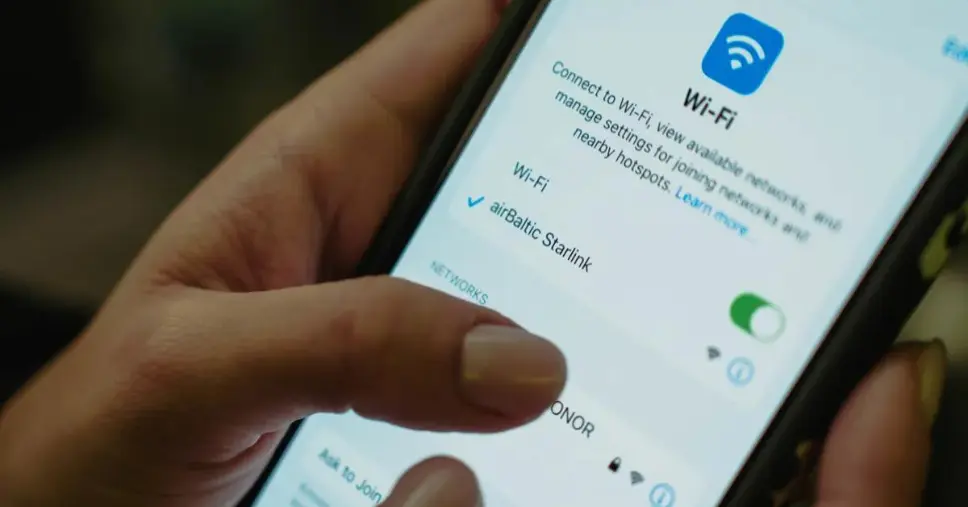Do airplanes have Wi-Fi? Absolutely! Many airlines now offer in-flight internet, allowing passengers to browse, stream, work, or message from thousands of feet in the air. Staying connected while flying has quickly become a standard expectation for modern travellers. With advancements in satellite and air-to-ground technology, being offline while flying is becoming a thing of the past. In this article, we’ll explore how it works, which airlines offer it, and what you need to know before you connect.

What is Airplane W-iFi?
Airplane Wi-Fi, also known as in-flight Wi-Fi, is a wireless internet service that allows passengers to stay connected while flying. Whether you’re checking emails, streaming your favourite series, browsing the web, or messaging friends, in-flight Wi-Fi makes it all possible — even at 35,000 feet.
As connectivity becomes more important to modern travellers, airlines are increasingly offering this service to enhance the flying experience. In fact, a 2022 survey found that 83% of passengers said a good Wi-Fi experience would make them more likely to fly with the same airline again, turning it into a key factor in customer loyalty.
How Do Airplanes Have Wi-Fi?
Staying online while flying might feel like magic, but it’s powered by some very clever tech. There are two main types of in-flight Wi-Fi systems, and each works a bit differently depending on where you’re flying.
- Air-to-Ground (ATG): Connects the aircraft to ground-based cell towers. This system works best over land, with the signal passed between towers as the plane moves, much like how your phone stays connected when driving.
- Satellite-Based: Uses satellites in orbit to maintain a steady connection. Ideal for long-haul or transoceanic flights, this system ensures coverage even over oceans and remote regions.
These systems deliver the internet to the aircraft, but how does it actually reach your phone or laptop?
How the connection flows:
- Antennas on the plane (top or underside) pick up signals from ground towers or satellites.
- The signal is passed through an onboard server system.
- Routers and access points distribute Wi-Fi throughout the cabin.
- Passengers connect via their devices — phone, tablet, or laptop.
It’s basically your home Wi-Fi, just flying 30,000 feet in the air.
How Reliable Is In-Flight WiFi on Airplanes?
The reliability of in-flight Wi-Fi can vary quite a bit, depending on a number of factors. One key element is the technology being used. Some systems only work once the plane reaches a certain altitude, which isn’t ideal for short-haul flights where cruising time is limited. The type of airline also makes a difference — premium carriers like Emirates and Qatar Airways are known for offering excellent connectivity, while others like JetBlue, Lufthansa, KLM, and Southwest provide free Wi-Fi to all passengers, helping them stand out among both local and international travellers.
The aircraft itself also plays a role. Not all planes are equipped for in-flight internet, especially smaller models or those used on regional routes. Flight distance and terrain can also affect connectivity — long-haul flights tend to offer better coverage, while routes over mountains or remote areas may struggle to maintain a stable signal. High demand on board can slow speeds, and in some cases, bad weather can interfere with satellite-based systems.

Airlines With Reliable WiFi
Many airlines across the globe now offer in-flight Wi-Fi, with varying levels of coverage, speed, and pricing. Below is a regional breakdown of some of the most notable airlines known for providing reliable Wi-Fi services in North America, Europe, and Asia.
| North America: | Europe: | Asia: |
|---|---|---|
|
|
|
Do You Have to Pay Extra for Airplane Wi-Fi?
Some airlines offer free WiFi while others offer paid packages. Passengers may also be requested to pay a small fee for internet access.
Pricing Models to Consider
Wi-Fi pricing is typically divided into two categories, which are explained as follows:
- Pay-Per-Use: This option allows passengers to pay for the exact amount of Wi-Fi and data they have used. This is done via an app while you’re on the flight. Keep in mind that these costs can be up to 40% higher than a subscription.
- Subscription: Airlines offer Wi-Fi packages that can be paid monthly or yearly. These are ideal for regular flyers.
In addition to these categories, you can buy different packages, such as:
- Surfing package: Typically provides basic internet access for browsing websites, checking emails, and social media. It’s ideal for light usage, such as reading articles or browsing the web, without consuming too much data. This package usually has a lower cost compared to more data-heavy options.
- Streaming package: Offers higher-speed internet, allowing passengers to stream movies, TV shows, or music. It is designed for those who want to enjoy entertainment during their flight. This package is pricier than the surfing option, as it requires more bandwidth to handle video and audio streaming smoothly.
- Texting package: Allows passengers to send and receive text messages during the flight, either via SMS or messaging apps. It’s perfect for staying in touch with friends or family without the need for full internet access. This package is generally affordable and offers a convenient way to communicate while in the air.
With some airlines, you can buy WiFi passes before your flight. For example, KLM airlines give an opportunity to buy a WiFi pass prior to boarding.
But if you fly business class or first class, you mostly already have an included WiFi package.
Speed of Airplane WiFi: What to Expect on International Flights
When you’re reviewing the services provided by your local airline, you may also be checking into the airplane Wi-Fi speed. Most routes offer a Wi-Fi speed of 10 to 15 Mbps, which is ideal for basic online tasks such as internet browsing, emailing, or other simple online functions.
The Starlink Factor
Starlink is a satellite network currently operated by SpaceX. This network offers in-flight entertainment options such as streaming, gaming, and shopping. Internet access is available on seatback screens and personal devices. Aircraft, like AirBaltic, that have partnered with Starlink are currently boasting in-flight WiFi speeds of at least 500 Mbps. This breakthrough technology provides passengers with high-speed internet, enhancing their in-flight experience and marking a significant step forward in air travel connectivity.
Alternatives to Airplane WiFi: Using eSIM for Connectivity and Internet Access
If you’re looking for an affordable alternative to expensive plane Wi-Fi, then it’s time to consider eSIM technology. Opting for an eSIM from Esimatic allows you to use an eSIM rather than a traditional SIM card.
With a wide range of travel packages to choose from, you can purchase an eSIM that allows you to access the mobile data on your existing plan. There’s no need to buy an additional SIM card or use expensive Wi-Fi. You also won’t be exposed to costly roaming charges.

Stay Connected Anywhere—Download Esimatic eSIM App!
Enjoy hassle-free mobile data plans that keep you online in Europe, the USA, and beyond.
Manage Your In-Flight Data More Effectively
There are a few ways to manage your data usage while in the air. These include:
- Enable airplane mode to disable regular cellular data.
- Download videos, e-books, and other content before boarding the plane to view offline. Where possible, download before the flight rather than stream in-flight.
- Limit background data by activating Data Saver Mode on Android or Low Data Mode on iPhone.
Whether you’re planning to fly business class or economy class, part of your travel plans should include finding the perfect eSIM for your next flight.
Travel Tips for Using In-Flight Wi-Fi Efficiently on Long-Haul Flights
Keeping your in-flight Wi-Fi fee at a minimum will depend on how efficiently you use your data and online time. Consider these few best practices to get the most out of your mobile data.
- Use a VPN to increase your online security.
- Be mindful of bandwidth—avoid downloading excessively large files.
- Pause your automatic updates and cloud services.
- Invest in an eSIM data plan designed for travel.
- Plan your data usage and download apps and programmes that can be viewed offline.
- Look for games, puzzles, and reading apps to keep your family busy during the flight. Common examples of these include podcasts for kids and offline messaging apps such as FireChat, Briar, and Bridgefly.
Stay connected in the air and save on roaming charges with our additional tips.
Airplane WiFi Cost: Is It Worth Paying for WiFi on Airplanes
Whether or not paying for Wi-Fi is worth it depends on the purpose of your flight. Having access to Wi-Fi can be useful if you need to stay up-to-date with work emails or messages. It’s also an excellent way to keep kids entertained on long-haul routes. To help you decide if you need Wi-Fi on your next flight, consider our list of pros and cons.
Pros
-
Enables you to stay connected
-
Provides entertainment
-
Allows you to be more productive if you want to use the time to work
-
Lets you stay in touch with people and also check on your travel plans
Cons
-
Can be costly if you’re opting for the pay-per-service option
-
Turbulence can affect signal strength
-
Can drain your device’s battery much quicker
-
Potential vulnerability to network hacking
How to Stay Connected and Save on Costs
In-flight Wi-Fi has quickly gone from a novelty to a valuable travel essential. While it’s incredibly convenient to stay connected in the air, it’s important to understand the costs, speed limitations, and security risks that can come with it. Knowing how the technology works — and which airlines offer the best service — can help you make smarter choices when you fly.
As more carriers roll out faster and even free Wi-Fi options, it’s becoming easier than ever to work, message, or stream mid-flight. For even greater flexibility once you land, consider setting yourself up with an eSIM. It’s a hassle-free way to access affordable data plans worldwide — no roaming surprises, no SIM swaps. Whether you’re flying short-haul or long-haul, staying connected doesn’t have to break the bank.
FAQ
On some flights, yes — especially those with satellite-based or Starlink connections. However, you might need to purchase a higher-tier plan, and quality may vary depending on network demand and flight location.
The addition of modern technology, such as Starlink, has significantly increased the speed of in-flight Wi-Fi. While average speeds can range from 10 to 15 Mbps, airplanes with Starlink can boost Wi-Fi speeds to an impressive 500 Mbps. These speeds are ideal for all types of basic mobile functions, such as emailing, regular browsing, and social media.
An eSIM is an effective alternative to traditional airplane Wi-Fi, providing a more reliable and seamless connection while travelling. With an eSIM, you can stay connected to your own network or easily switch to local networks in various countries, ensuring secure and hassle-free mobile data usage during your flights and trips. This technology eliminates the need for physical SIM cards, offering convenience and flexibility for global travellers
It depends on the airline. Some, like JetBlue and Delta, offer free Wi-Fi to all passengers. Others may charge a fee or offer it free only to loyalty programme members or premium class passengers.
Travellers can easily use Wi-Fi on their phones during a flight if the airline provides an in-flight Wi-Fi option. An additional requirement is for the phone or device to be in airplane mode. This is to prevent interference with the aircraft’s communication system. Modern mobile devices allow for features such as Bluetooth and Wi-Fi to be manually switched on and off even in airplane mode.
Airplane Wi-Fi isn’t available on all flights. In many instances, Wi-Fi availability depends on the selected aircraft type, route, and airline. Fortunately, more airlines are starting to offer Wi-Fi coverage on newer models as part of their enhanced customer experience.